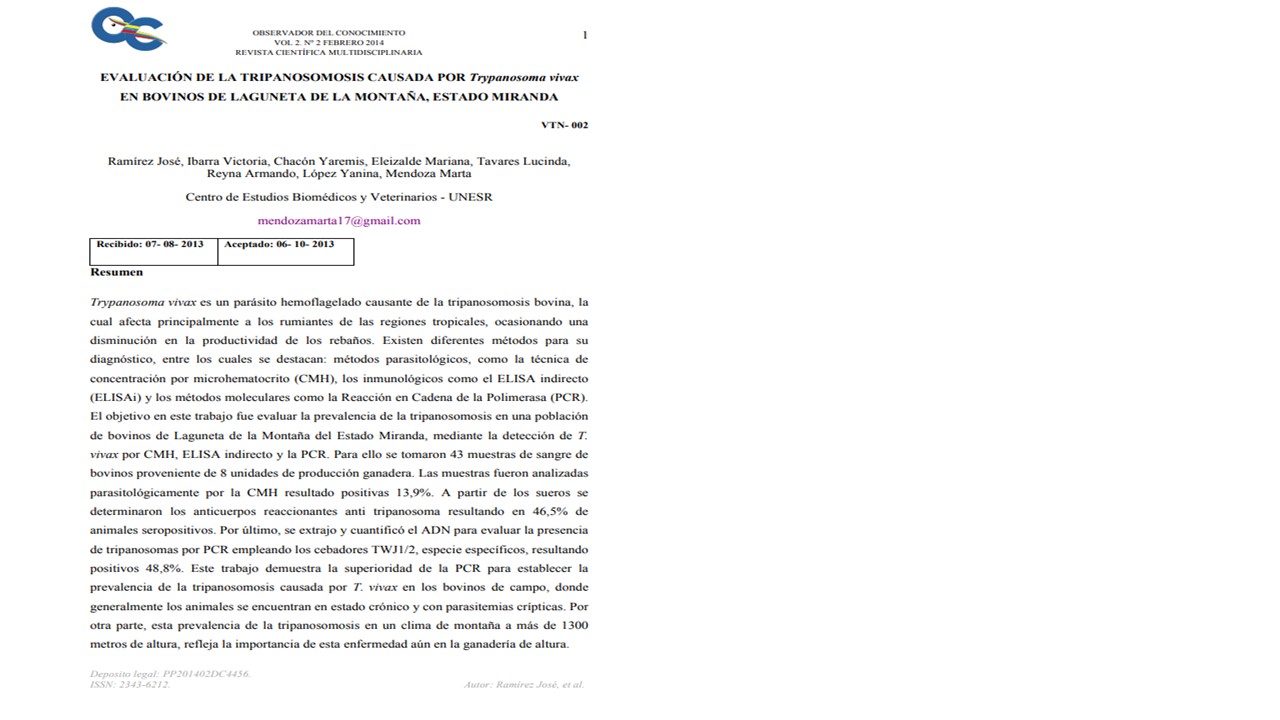Evaluation of The Tripanosomosis Caused by Trypanosoma Vivax in Bovine of Laguneta From The Mountain, State Miranda
Keywords:
Trypanosome vivax, trypanosomosis, diagnosis, bovines, Laguneta de la MontañaAbstract
Trypanosoma vivax is a hemoflagellate parasite that causes bovine trypanosomosis, which mainly affects ruminants in tropical regions, causing a decrease in herd productivity. There are different methods for its diagnosis, among which stand out: parasitological methods, such as the technique of concentration by microhematocrit (CMH), immunologicals such as indirect ELISA (ELISAi) and molecular methods such as the Polymerase Chain Reaction (PCR). ). The objective in this work was to evaluate the prevalence of trypanosomosis in a population of cattle of Laguneta de la Montaña of Miranda State, by detecting T. vivax by CMH, indirect ELISA and PCR.
Downloads
References
Bolívar, A.M; García-Lugo, P; Crisante, G; Rojas, A; Teixeira, M; Añez, N. (2006). Detección de infecciones subclínicas por Trypanosoma vivax en bovinos de fincas ganaderas de Mérida, Venezuela. Boletín de Malariología y Salud Ambiental. 87-90.
Desquesnes, M. (2004). Livestock Trypanosomes and their Vectors in Latin America. Centre de cooperation internationale en recherché agronomique pour le développement (CIRAD)/ Élevageetmédecinevétérinairetropical (EMVT). OIE Paris. 174 pp.
Holland, G; Claes, F; My, L.N; Than, N.G; Tam, P.T; Verloo, D; Büscher, P; Goddeeris, B; Vercruysse, J. (2001). A comparative evaluation of parasitological tests and a PCR for Trypanosoma evansi diagnosis in experimentally infected water buffaloes. Veterinary Parasitology. 97: 23–33.
Holmes, P.H; Katunguka-Rwakishaya, E; Bennison, J.J; Wassink, G.J; Parkins, J.J. (2000). Impact of nutrition on the pathophysiology of bovine trypanosomiasis. Parasitology. 120:73- 85.
Luckins, A.G; Gray, A.R; Rae, P. (1977). Comparison of diagnostic value of serum immunoglobulin levels, an enzyme- Linked immunosorbent assay and a fluorescent antibodytest in experimental infections with Trypanosoma evansi in rabbits. Annals of Tropical Medicine Parasitology. 72: 449-441.Masake, R.A; Majiwa, P.A.O; Moloo, S.K; Makau, J.M; Njuguna, J.T;
Maina, M; Kabata, J; Ole, Loi. Yoi. OK; Nantulya, V.M. (1997). Sensitive and specific detection of Trypanosoma vivax using the polymerase chaín reaction. Experimental Parasitology. 85: 193–205.
Monzón, C. M; Mancebo, O. A; Ruso, A. M. (2003). Antibody levels by indirect ELISA test in Trypanosoma evansi infected horses following treatment with quinapyramine sulphate. Veterinary Parasitology. 111: 59–63.
Paris, J; Murray, M; McOdimba, F. (1982). A comparative evaluation of the parasitological techniques currently available for the diagnosis of African trypanosomiasis in cattle. Acta Tropical. 39: 307–316
Ramasamy, R; Surendran, S.N. (2012). Global climate change and its potential impact on disease transmission by salinity-tolerant mosquito vectors in coastal zones. Frontiers y Physiology. 3: 198.
Ramírez-Iglesias, J.R; Eleizalde, M.C; Piñeres-Gómez, E; Mendoza, M. (2011). Trypanosoma evansi: A comparative study of four diagnostic techniques for trypanosomosis using rabbit as an experimental model. Experimental Parasitology. 128 (1):91-96.
Simoes, D; Sánchez, M; Yllenck, G; Rivera, F; Parra, R; Quijada, J; García, F. (2009). Brote de tripanosomosis en un rebaño doble propósito del municipio Mara del estado Zulia, Venezuela. Ciencia. 17(2): 124-132.
Suarez, C; García, F; Román, D; Coronado, A; Perrone, T; Reyna, A; Parra, N. (2009). Factores de riesgo asociados a la tripanosomosis bovina en explotaciones de Venezuela.
Tamasaukas, M; Rivera- Pirela, S. (2010). Hemoparasitosis en ganadería doble propósito venezolana, diagnóstico y control: Una revisión. Agronomía Mesoamericana. 21 (2): 383-386.
Toro, M; León, E; López, R; García, J.A; Ruiz, A. (1980). Resultado de un muestreo sobre tripanosomiasis bovina mediante técnicas serológicas. Veterinaria Tropical. 5: 43-50.
Uzcanga, G; Mendoza, M; Aso, P; Bubis, J. ( 2002). Purification of a 64 kDa antigen from Trypanosoma evansi that exhibits cross-reactivity with Trypanosoma vivax. Parasitology.124: 287-299.
Woo, P.T.K. (1970). The haematocrit centrifuge technique for the diagnosis of African Trypanosomiasis, Acta Tropical. 27: 384-386.
Zootécnica Tropical. 27(4): 363-372. Tamasaukas, R; Agudo-Castellanos, L; Silva-Ravelo, A; Florio-Luis, J; Vintimilla-

Downloads
Published
How to Cite
Issue
Section
License

This work is licensed under a Creative Commons Attribution-NoDerivatives 4.0 International License.







